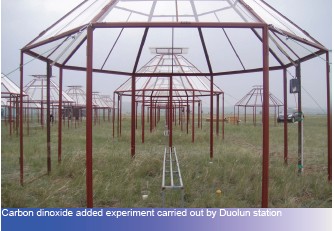The Doulun Restoration Ecology Experimentation and Demonstration Station lies at the southern part of the Xilingele League of Inner Mongolian Autonomous Region and is located at the southern end of Hunshandake. The Station has taken basic research on restoration ecology of degraded ecosystems in agro-pastoral ecotone and focused on experimentation and demonstration. This is accomplished through long-term ecological orientation, observation, and experimentation which reveal the damaging mechanisms of a typical degraded ecosystem in agro-pastoral ecotone. This is done in order to rehabilitate the ecosystem by selecting a high-level ecology- productive pattern. Effective techniques will be developed and studied in order to recover and reestablish sandy vegetation, improve degraded grassland and renovate the damaged agro-ecosystem. The station will provide theoretical ideology, technological support and ideas for comprehensive treatment of the eco-environment in this area, in order to promote the regional eco-environmental establishment and to sustainably develop the social economy of this area. Recent years, the Station has obtained excellent results on field original controlled experiment under the background of grobal change. The Station has four open experimental platforms and near 100 hectares' experimental plots. The Station can receive 30 scientific staffs to do research every year. In 2011, the Station had 3 on-face projects from National Nature Science Foundation, 5 projects from CAS and Ministry of Science and Technology, and published 6 theses, among that 5 were SCI.
We used manipulative experiments to examine changes in terrestrial plants and ecosystem in response to the driving factors of global change (global climate warming, changes in precipitation, nitrogen deposition). The multifactor involves climate warming (infrared heaters), changing precipitation regimes (increasing precipitation by 30% in spring or summer), nutrient (nitrogen and phosphorus) addition, and clipping. The aim of the study was to examine the main and interactive effects of multiple global change driving factors in affecting ecosystem C processes and pools. The project is important for understanding the changes and the underlying mechanisms of ecosystem primary productivity and C sequestration in response to global change. The results
showed that: (1) water mediated ecosystem carbon fluxes and their responses to climate change; (2) the acclimation of grassland carbon sequestration to N addition; (3) water and nitrogen addition had non-additive effects on ecosystem carbon exchange in a temperate steppe. The nocturnal warming experiment showed that effects of diurnal warming on soil respiration were not equal to the summed effects of day and night warming in a temperate steppe. This indicates that the responses of ecosystems to climate warming can not be predicted by diurnal warming simply.

